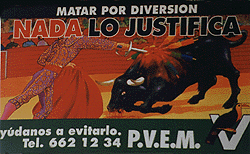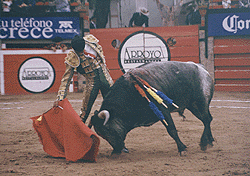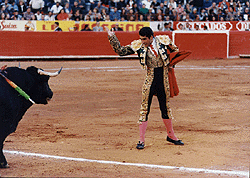| � | ||||||||||||||||||||||||
| musicjam aficionado | ||||||||||||||||||||||||
| � | ||||||||||||||||||||||||

|
A bull-fight is known as a corrida de toros, or a novillada if the bull-fighters have not progressed beyond the apprentice stage, and takes place in the plaza de toros. In most corridas six bulls are fought, two by each of three matadors, with each fight taking around 20 minutes. The least experienced matador takes the first and fourth bulls, the most experienced the third and last bulls. The matadors or their agents will first draw straws in order to determine the allocation of bulls. The bull-fighting team consists of the matador (the star) and his assistants: typically 3 banderilleros and 2 picadores. The matador wears a bright coloured costume known as the suit of lights. His assistants wear less outrageous costumes. The movement from act to act in the bull-fight is heralded by a trumpet blast. The first trumpet signals the paseo or march of the bull-fighters and the second trumpet the entrance of the bull. The matador first watches his chief assistant perform some passes with the yellow and magenta cape in order to determine the bull's qualities and mood, before taking over himself. During this period the matador is testing the bull's speed, power and tendencies to hook one way or the other. Information learnt now is crucial for a successful faena. | |||||||||||||||||||||||
| � | ||||||||||||||||||||||||
| Picadores, Banderilleros, Faena | ||||||||||||||||||||||||

|
Picadores The third trumpet signals the entrance of the mounted picadores who carry long pikes with a steel tip which is prevented from going more than four inches into the bull's flesh by a metal guard. The bull carries its head and horns high and the aim of the picador is to weaken the massive tossing muscle (morrillo) between the shoulder blades. When the bull charges, the picador leans out and thrusts the pike into the bull's shoulders. The brave bull disregards the pain and charges the harder into the pike. The cowardly bull backs away and is reluctant to charge again and may be booed by the crowd. The trial of the picks is over when the bullring president decides but usually after 2 or 3 picks, which are spearated by a quite, or rescue, in which the bull is lured away from the horse by the banderilleros. Banderilleros Following the fourth trumpet the banderilleros attempt to place their banderillas in the bull's withers, again with the aim of weakening the bull so that the matador is able to work more closely with it. The banderillas are wooden sticks decorated with coloured paper and with a steel harpoon on the end. The banderilleros usually run in a quarter circle leaning over the bull's horns to place the banderillas. Up to four pairs are placed one of which the matador will generally place himself. Faena The matador now removes his black winged hat on the fifth trumpet and dedicates the death of the bull to the president or the crowd before beginning his faena. It is the faena which is the most beautiful and skillful section of the fight and where the matador must prove his courage and artistry. The faena consists of a series of passes made with the muleta, a piece of thick crimson cloth draped over a short stick, which can be held in either the left hand or draped over the espada, the killing sword, which is always held in the right hand. The classic pass is called the natural in which the muleta, in left or right hand, is first held in front of the matador to site the bull and is then swung across and away from the matador's body hopefully taking the bull with it. | |||||||||||||||||||||||
| � | ||||||||||||||||||||||||
| Corrida de toros | ||||||||||||||||||||||||

A left handed natural is always more highly regarded than a right handed natural since when the muleta is draped over the espada the area of cloth visible to the bull is increased thereby allowing for a greater margin of error by the matador. The matador will continue to perform a number of different passes varying in skill and flamboyance until he has demonstrated his complete control over the charging bull. | The bull is now ready to be killed. The matador stands some ten feet from the bull, keeping the bull fixated on the muleta held low in the left hand, and aiming the espada between the shoulder blades. The matador attacks pushing the espada over the horns and deep between the shoulder blades. If the sword goes in to the hilt it is an estocada but if it hits bone it is a pinchazo or media-estocada. An estocada usually results in the bull dropping immediately to its knees and dying, but if the bull fails to die the matador may take the descabello a sword with a short cross piece at the end which he stabs into the bull's neck severing the spinal cord. The fight is over. The matador may be awarded trophies by the president, according to his bravery and skill while working with the bull, which range from one ear up to two ears, the tail and the hoof. The crowd will often encourage the president to award the trophies by waving white hankerchiefs, and this waving continues after the trophies have been awarded in an attempt to get the matador to throw his trophies into the crowd. The crowd in return hurls flowers which are collected by the matador's assistants. �
|
Favourite links
|
|
| ||||||||||||||||||||
